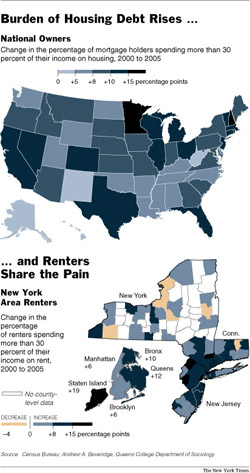_Getting Graphic is a semi-sort-of-irregular collection of our favorite BIG real estate-related chart(s)._
[Click here for large graphic [NYT]](http://www.nytimes.com/imagepages/2006/10/02/nyregion/20061003_CENSUS_MAP.html)
Housing costs (mortgage or rental) have risen sharply over the past five years according to new data by the Census Bureau and presented in the article by Janny Scott and Randal C. Archibald called [Across Nation, Housing Costs Rise as Burden [NYT]](http://www.nytimes.com/2006/10/03/nyregion/03census.html?_r=1&th=&adxnnl=1&oref=slogin&emc=th&adxnnlx=1159869635-uQotyeco2pjM7gnTYWUgWQ&pagewanted=all).
The data was collected through 2005 so it does not reflect further rising mortgage costs and rental costs in 2006.
Over the period, there was a large increase in homeowners paying more than 30% of their income on housing. They are not alone. There has been a surge in renters paying more than 30% of their income as well.
Why?
>“People want to hang on and stay in the market,” said William H. Frey, a demographer at the Brookings Institution in Washington, “and they are willing to stretch themselves to find or to rent a house that is suitable.”
>S. Lawrence Yun, an economist with the National Association of Realtors, said renters in desirable cities might be spending more of their income on housing in hopes of getting a toehold in places with good schools, better homes and a good quality of life. He said, “There is certainly a concern that people are devoting a large portion of their income to housing, and one of the reasons is due to the more limited housing supply.”
Its an interesting dilemma because conventional wisdom says that those priced out of the housing market during the boom, will simply rent and wait for the market to be more affordable, but at the same time rents are rising rapidly as many have the same idea. Here in New York, the rental market is currently doing what the sales market just got through doing.
The most pronounced increases in housing appear to be in urban areas, many of which have been revitalized in recent years but suburbs also showed significant gains in housing costs. In many metro areas, the surrounding suburbs have reached _price parity_ making the move to the suburb one of lifestyle and not of cost savings.
Its possible that certain sales markets may benefit from a rental _bounce back_ as home buyers become discouraged and decide to go to rentals only to suffer further dissappointment when they realize how much rents have gone up at the same time. Either way, its looking more expensive these days.
It certainly makes for the argument of Fed interest rate cuts in 2007 as the economy cools off.
One Comment
Comments are closed.


I’m surprised the number of people in NYC spending 30% of their income is so low. I certainly spent more than that when I lived on Avenue A. On a side note, I will suggest to the NYT that Boulder and College Station, where nearly 50% of renters spend 50% of their income are both home to large public universities, so the incomes may be skewed.
As one who now manages a portfolio of workforce housing communities across the midwest and south, we’re noticing a nice uptick in occupancy and a gentle increase in rents. We don’t operate in markets like DC, where the ‘conversion’ fad removed a large portion of the managed rental stock (as opposed to investors who will rent individually), so rents are rising because of demand, not a lack of supply.
That said, I don’t agree with Mr. Frey that people necessarily stretch to rent as much as they stretch to buy. I think they rent where they feel safe, find attractive amenities, and can make their rent payments without unreasonably stretching.